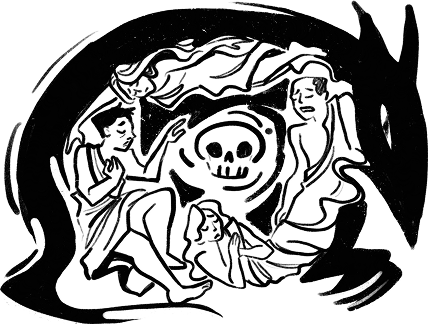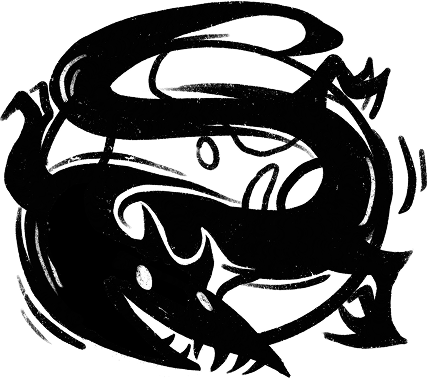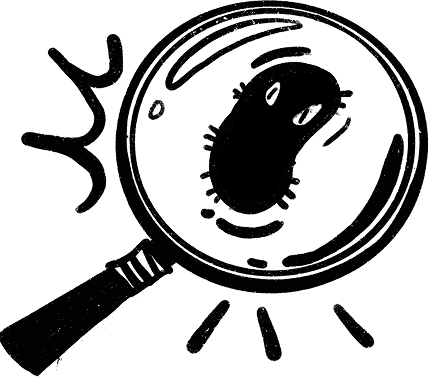Category: Cognitive technologies
A Feast in time of Plague: What people ate, drank, and believed in during worldwide pandemics
“Epidemics are not historical anomalies but a natural feature of life amidst microbes”
Sonia Shah, Pandemic: A History of Deadly Viruses
And may health be with you, mortals. I, the Plague Doctor, a not-unknown physician from the Middle Ages and the Renaissance, address you in these troubling times. Some of you have already forgotten, while others never even knew, that human history is full of terrible pandemics that left an indelible mark and took the lives of a great number of living souls. The Black Death alone “mowed down” millions of people in the 14th century, when fear and confusion engulfed all of Europe. Then came the Spanish flu, which struck a third of the Earth’s population and claimed over 50 million souls. Besides them, cholera, smallpox, and the Ebola virus raged across the globe… And in 2019, all those now living encountered the coronavirus. This disease also claimed many lives, but compared to the horrors humanity endured in the past, it seems like a common cold.
My goal is to tell you the whole truth about the pandemics of the past and even show you some fragments that I myself would like to forget. Do not forget to wear a mask with a beak-like nose. Or at least a regular medical one. And do not inhale too deeply; bacilli could be anywhere.
Legions Did Not Only Bring Spoils
The years 160-180 AD. Even before this period, life for people in the Roman Empire was far from peaceful. The war with Parthia in Mesopotamia was wiping thousands of lives from the face of the earth, but this was only the beginning of the terrible pestilence that engulfed all of Rome after the military actions ended. It started with a high fever, to which new symptoms gradually added: diarrhea, pharyngitis, fever, and a dry or pustular skin rash. The disease spread rapidly throughout the territory of Rome, likely brought home by returning troops. No one knew how to treat the unknown ailment, and so for two decades people died in terrible agony without any chance of recovery.
At times, the number of daily deaths reached two thousand people: there were neither medicines nor any understanding of what kind of epidemic had gripped the Roman people. Later it was dubbed the Antonine Plague—after the Roman ruler of that time, Marcus Aurelius Antoninus—but today it is better known as the Plague of Galen. It received its second name thanks to the work of the Greek physician and writer Galen, who conducted his own observations and described the dangerous disease in his treatise “Methodus Medendi.”

Local inhabitants, both sick and healthy, clutched at any means to protect themselves from the sickness and universally engaged in magic and sorcery. Roman physicians offered patients bloodletting and the administration of medicinal herbs. Later, doctors began isolating the sick from the healthy and improving sanitary conditions, yet even this was not enough to defeat the disease. Death stood on the thresholds of homes, smiled in faces, and breathed down necks. In the end, it claimed the lives of five million people, destroyed about a third of the population in some Roman provinces, and severely weakened the might of the army.
The cessation of the disease’s spread in the 180s was not linked to the emergence of medicines or treatments; the outbreaks of the Antonine Plague subsided after the death of Marcus Aurelius. Many scholars associate the Antonine Plague with an outbreak of smallpox—a disease no one in Europe had contracted in those historical times, meaning they had no immunity against the dangerous illness. Whether this is true remains unknown to this day.
The Plague of Justinian: The First Globalization of Death
The years 541-750 AD. The second terrible epidemic did not keep the world waiting long. This time, it did not confine itself to a single state and reached into every corner of Europe, North Africa, Central and South Asia, and Arabia. Suddenly, across the globe, people began developing horrifying symptoms: swollen lymph nodes, fever, shortness of breath, rapid pulse, nausea, vomiting, hallucinations, and the appearance of characteristic swellings over the entire body—buboes. In severe cases, patients exhibited a hemorrhagic rash and coughed up blood. Thus began the Plague of Justinian.

The epidemic received its name in honor of the Byzantine Emperor Justinian I, as it was from Byzantium that the disease entered Europe aboard trading ships. Interestingly, until 2017, there was no precise data on the exact origin of the Plague of Justinian. Only recent research has shown that the carriers of the terrible pestilence were infected rats and fleas from the Celestial Empire. People still had no antibiotics or effective medicines, so the sick were treated with cold baths, purging the body using smoke and heat, ingesting special powders made from medicinal herbs, and tinctures of alkaloids. People still relied on magic, using various amulets and rings for protection against the disease. Need it be said that none of this helped? The numbers speak for themselves: the first recorded global pandemic claimed the lives of over ninety million people across the Earth. The consequences of the plague hit Europe and Byzantium the hardest, which lost about half of their population.
The Plague of Justinian ended as it began, but from time to time it reminded the world of itself with new local outbreaks.
The Black Death: When Masks Became the Main Uniform of Survival
1338-1353. The epidemic of Bubonic Plague, or, as it is poetically called, the Black Death. This is the one all contemporaries know well, naively believing it was the first and only outbreak, but that is not the case. The Bubonic Plague swept over China, Mongolia, Syria, Egypt, India, and all of Europe, shattered the accustomed way of life, and brought with it countless deaths in terrible agony.
Once again, the carriers of the disease were rats and fleas. People were infected en masse with the dangerous ailment, exhibiting symptoms such as weakness, nausea, vomiting, headache, muscle aches, fever with a body temperature of 39-40 degrees, swollen lymph nodes, dropping blood pressure, a hemorrhagic rash over the body, cough, and phlegm mixed with blood. The plague inspired horror with its speed of spread and its lethality—99% of the infected died in torment. It was then that Plague Doctors first appeared, wearing protective attire consisting of a long cloak of waxed leather, masks shaped like sharp bird beaks filled with fragrant herbs or other substances to protect against “infected” air, and canes for contact-free examination of patients.
During the time of the Black Death, all streets were saturated with the foul stench of rotting bodies and the herbs people used to try to ward off the disease. The silence in homes was broken by the groans of the sick and the dying sighs of those who remained alive. The corpses of the deceased were often dumped into rivers, as there soon ceased to be enough space for burials. People sought solace in religion, gathered in churches, and prayed for salvation and forgiveness, while those who did not believe in God turned to magic and sorcery. But neither God, nor the Devil, nor magical spells could stop the Bubonic Plague—it continued to enter every house, every family. It was then that people began locking themselves in their homes and isolating themselves from society to protect themselves from the disease. It is believed that this helped stop the spread of the Bubonic Plague and gradually reduce the epidemic to nothing. But even without that, the Black Death’s record, after the epidemic had passed, listed approximately two hundred million people.

How to Find the Bacterium and Still Lose
1855-1910. The world once again fell under the power of the bubonic plague. This time, it all started in the Chinese province of Yunnan and spread across the entire globe. There was still no cure for the disease, so in India and China alone, which had the highest proportion of cases, approximately 12 million people died during this new pandemic.
However, in 1894, hope emerged thanks to the work of French biologist Alexandre Yersin. Through research in Hong Kong, he identified the dangerous bacterium Yersinia pestis, which was transmitted through the bites of rodents and fleas and was the cause of plague infection. This discovery marked the beginning of the development of modern treatments for dangerous diseases, such as insecticides, antibiotics, and vaccines. By 1910, the epidemic began to subside, but according to the World Health Organization, its echoes continued until 1960.

The plague has still not been completely eradicated: about 200 people die from it annually in low-income countries like the Congo, Madagascar, and Peru. There are also plague foci in some regions of Russia. However, another plague epidemic is not expected, as people now have all the necessary medicines to prevent the mass spread of the disease.
The Only Virus Humanity Has Killed with Its Own Hands
The timeline of another terrible pandemic is too vague to be stated with precision. This refers to smallpox—the only dangerous virus to have been completely eradicated. The first mentions of smallpox are found in the works of ancient physicians, and the first documented epidemic occurred in China in the 4th century.
Between the 7th and 8th centuries, Muslim Arabs spread the disease from Spain to India, and a major epidemic struck Japan in 735–737, claiming about one-third of the country’s population. From the 15th century onward, smallpox raged almost continuously across Europe, and there was not a single person who managed to avoid the disease. The infected developed fever, pains in their limbs, and horrifying ulcers that spread across the entire body within a few days. In the later stages of the illness, people experienced delirium, convulsions, and confusion. Most often, the disease ended in death, and those who managed to survive and recover were left with terrible scars and marks where the ulcers had been.
Smallpox terrified people to the point of driving them mad.
Initially, variolation was used to combat the virus—a vaccination involving pus from the pustule of a mildly infected person, which reduced the risk of contracting smallpox. In the 18th century, the English physician Edward Jenner discovered that milkmaids who contracted cowpox (a milder form of the disease) did not later contract smallpox. Based on these observations, Jenner used the cowpox virus as the foundation for the first vaccine against its deadly counterpart.

A full victory over smallpox was achieved only in 1980, thanks to decades of global population vaccination initiated after a proposal by the USSR at the 1958 World Health Assembly meeting. The history of smallpox as a threat to humanity ended in 1977, when the last case of the disease was recorded in Somalia. In total, smallpox claimed the lives of over 600,000,000 people.
Cholera: Seven Pandemics That Taught Us to Drink Clean Water
1816-1975. 159 years. Seven pandemics. One disease. And its name is cholera. The first documented outbreaks of the new disease were discovered in Bengal, from where the cholera epidemic began to spread rapidly along trade routes to the Middle East, Southeast Asia, East Africa, and Europe. Mentions of this disease can be found as far back as ancient Indian manuscripts from the 5th century BC.
Cholera is an intestinal infection with characteristic symptoms: watery diarrhea, sudden vomiting, severe dehydration with dry mouth and skin lesions, muscle cramps, hoarseness, and reduced urine output. In severe cases of the disease, patients’ eyes become sunken, their lips and limbs turn blue, blood pressure drops, and some even fall into a coma.
The first cholera pandemic of 1816-1824 claimed the lives of over 8 million people in India alone, as well as over one hundred thousand people in Korea and the island of Java. The disease’s mortality rate reached 60% among those infected, and measures taken in the form of quarantine and isolation of the sick did little to reduce the spread of the infection. The first pandemic was ended in some European countries by abnormally cold winters, which killed the bacteria in contaminated water bodies.
The second cholera pandemic began in 1829, and by 1832 the disease had seized all continents of the globe except Antarctica. Particularly terrible epidemics occurred in London, Paris, Berlin, and Vienna, where cholera struck down people by the thousands, infecting everyone from paupers to kings. The total number of victims exceeded 2 million, and the epidemic was only stopped in 1851, thanks to the introduction of strict quarantine measures and the forced isolation of the sick.

The third cholera pandemic occurred between 1852 and 1860. In 1854, the British physician John Snow conducted research and discovered that the main means of transmitting the disease was contaminated water. This discovery allowed scientists to begin work on finding medicines for cholera and ways to prevent further outbreaks. However, the disease continued to remind the world of itself from time to time, and history records seven official cholera pandemics, each of which claimed a large number of lives, and the last one has not subsided to this day. Cholera continues to affect countries with poor sanitation and weak healthcare systems annually.
The Spanish Flu: The War That Killed the Strong and Spared the Weak
1918-1921. The reign of another terrible disease, known as Spanish flu, Purple Death, the great influenza, H1N1 influenza, or simply “the Spanish flu.” The epidemic began at the end of the First World War and spread very quickly throughout the world. Only Antarctica managed to avoid the fate of the disease, thanks to weather conditions in which almost no infection can survive. The first cases appeared in the United States, but military censorship prohibited war participants from reporting personnel losses due to illness, so the first country to announce the epidemic was neutral Spain, after which the new virus was subsequently named.
Patients experienced headaches, low blood pressure, tachycardia, fluctuations in body temperature, coughing up blood, and, in some cases, a bluish-purple discoloration of the skin. High infectivity led to the rapid spread of the disease. Patients showed a rapid development of complications, which in most cases inevitably led to death. But sometimes the disease could be asymptomatic, and this was the most frightening thing. Curiously, young people in the prime of life died from the “Spanish flu” much more often than children or the elderly. The spread of the disease was facilitated by unsanitary conditions, vitamin deficiency, poor nutrition, and overcrowding.

The “Spanish flu” disappeared as suddenly as it had appeared. According to scientists, the flu mutated into less lethal strains, although there is still no conclusive evidence to confirm this hypothesis. Over the three years of the Spanish flu pandemic, more people died than during both world wars—approximately one hundred million people.
HIV: The Virus That Forced Humanity to Rethink Everything—From Medicine to Morality
Finally, the year 1981 marked the beginning of another deadly pandemic that remains a threat even today. The human immunodeficiency virus—known as HIV—officially emerged in the United States in 1981, but according to scientists, the disease first made itself known much earlier.
The first carriers of HIV infection are believed to have been monkeys, hunted by some tribes in the 1930s. The HIV-1 strain originated from chimpanzees, while the HIV-2 strain was transmitted to humans from small African monkeys. HIV-2 was more treatable and was often eliminated by the immune system. The main danger of the disease lies in the fact that, upon entering the body, the virus actively destroys cells of the immune system. This inevitably leads to a weakening of the body’s defense systems and the emergence of other diseases, with the critical point being AIDS—acquired immunodeficiency syndrome. HIV primarily spreads through blood: via blood transfusions, transplantation of infected tissue, sharing syringes, tattooing with equipment that has been in contact with an infected person, through dental instruments, etc. HIV can also be transmitted sexually or from mother to child during pregnancy, childbirth, and breastfeeding.
Currently, HIV treatment involves antiretroviral therapy, which allows infected individuals to live up to 70-80 years, whereas without any preventive measures, an infected person lives no more than 11 years.
Interestingly, some people have an innate immunity to this dangerous disease. For example, among the peoples of Scandinavia, a specific gene is occasionally found that destroys the disease immediately and without consequences. This is influenced by a rare genetic mutation, CCR5-delta 32, which prevents the virus from entering the body’s cells. There are also cases where, after HIV infection, the human body prevents the disease from progressing to AIDS due to a unique set of proteins in the blood that inhibit viral replication. This trait occurs in approximately one in 300 people. To date, over 40 million people worldwide have died from HIV and related illnesses, and the number of HIV-infected individuals is around 38 million.

The Lesson We Still Haven’t Learned
The global world is vulnerable. Modern medicine is our shield, ready to come to the rescue at any moment. And this shield requires our participation—from vaccination to the sensible observance of norms. As long as the alliance between science and society endures, we have a chance to face the next threat not as second-century Romans, but as a twenty-first-century civilization.
“People quickly let their guard down. Preoccupied with politics and conflicts, they become distracted from health issues, resulting in the rampant spread of diseases and pandemics”
Elif Shafak, The Island of Missing Trees
The cell divides into the nucleus and cytoplasm. Our journal divides into interesting facts and discoveries.
Thank you!




